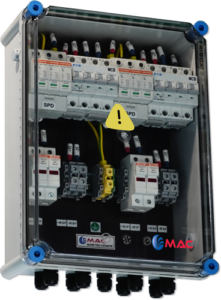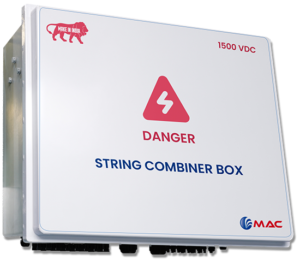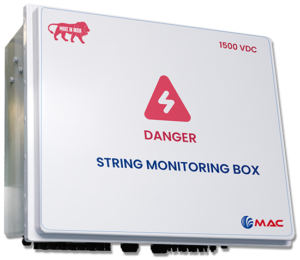Variant available
Customization
AC Distribution Box
- Available voltage range: 230 VAC ; 415 VAC ; 800 VAC & Up to 800A AC current
- Available in FRP/GRP/PC/CRCA enclosure
- Built-in MCB/MCCB (Thermal magnetic release or Microprocessor based) or AC Isolators
- Integrated surge protection devices (SPD)
- Class II insulation & Built-in energy meters
- Optional communication interfaces (e.g., RS485, Modbus, Ethernet)
- Alarm Indication: Visual or audible alarms for fault detection, overload conditions, or abnormal system operation.
- Ambient Temperature -10°C to +55°C
- In compliance with IEC 61439
Compliance & Warranty
About this item:
As the world transitions towards sustainable energy solutions, solar power plants have emerged as a cornerstone of renewable energy infrastructure. Central to the efficient operation of these plants are two essential components: the AC Distribution Box (ACDB) panel and the Low Tension (LT) panel. Manufacturing these panels requires a combination of cutting-edge technology, precision engineering, and a commitment to sustainability.
AC Distribution Box (ACDB) Panel:
The ACDB panel serves as a vital hub for distributing alternating current (AC) power generated by solar inverters to various loads and equipment within a solar plant. Here’s a glimpse into its manufacturing process and benefits:
- Design and Engineering: The ACDB panel is meticulously designed to accommodate the specific requirements of each solar plant. Engineers consider factors such as voltage levels, load capacities, and safety standards to create a custom solution that maximizes efficiency and reliability.
- Component Selection: High-quality components, including circuit breakers, switches, meters, and surge protection devices, are carefully selected for their performance, durability, and compatibility with solar power systems. These components undergo rigorous testing to ensure compliance with industry standards and regulations.
- Assembly and Testing: Skilled technicians assemble the ACDB panel with precision, following strict quality control protocols at every stage of the manufacturing process. Each panel undergoes comprehensive testing, including functional tests, insulation resistance tests, and temperature rise tests, to verify its performance and safety before installation.
- Integration and Customization: ACDB panels are designed for seamless integration with solar inverters, transformers, and other equipment in the solar plant. Manufacturers offer customization options to meet specific project requirements, such as communication protocols, monitoring capabilities, and enclosure materials.
- Benefits: By centralizing AC power distribution and protection functions, ACDB panels optimize the efficiency, reliability, and safety of solar power plants. They facilitate easy maintenance, troubleshooting, and monitoring, minimizing downtime and maximizing energy output.
Low Tension (LT) Panel:
The LT panel plays a crucial role in the distribution of low-voltage power within a solar plant, connecting various loads and auxiliary systems to the main electrical network. Let’s explore the manufacturing process and advantages of LT panels:
- Custom Design: LT panels are engineered to meet the specific voltage and load requirements of each solar plant. Design considerations include fault tolerance, load balancing, and future expansion capabilities, ensuring optimal performance and scalability.
- Component Procurement: Similar to ACDB panels, LT panels incorporate high-quality components sourced from reputable manufacturers. Circuit breakers, busbars, contactors, and protective devices are selected based on their reliability, efficiency, and compatibility with low-voltage systems.
- Assembly and Wiring: Skilled technicians assemble LT panels according to detailed schematics and wiring diagrams, adhering to strict quality standards and safety guidelines. Careful attention is paid to cable routing, insulation, and termination to minimize energy losses and mitigate electrical hazards.
- Testing and Certification: LT panels undergo rigorous testing, including insulation resistance tests, continuity tests, and operation tests, to verify their electrical performance and compliance with relevant standards. Certifications from recognized testing agencies provide assurance of quality and safety.
- Advantages: LT panels streamline the distribution of low-voltage power within solar plants, ensuring efficient operation and optimal utilization of electrical resources. They enhance system reliability, facilitate load management, and enable integration with backup power sources and energy storage systems.
Technical Specifications of Solar ACDB
1. Enclosure
• Material: Weatherproof and durable FRP/PC/Metal enclosure, in case of metal enclosure typically made of powder-coated aluminum or stainless steel.
• Protection Rating: IP65 or higher for protection against dust, water, and environmental elements.
• Dimensions: Customizable to accommodate internal components and installation requirements.
• Mounting: Wall-mounted or floor-mounted options available for flexible installation.
2. Input/Output Terminals
• Rated Voltage: Compatible with standard AC voltages, typically ranging from 230V to 800V AC.
• Rated Current: Depending on system capacity, rated currents may range from 10A to 200A per phase.
• Connection Type: Screw terminals or busbar connections for reliable and secure electrical connections.
• Cable Entry: Multiple cable entry points with gland plates for easy cable routing and termination.
3. Circuit Protection
• Circuit Breakers: Rated for AC operation and equipped with appropriate breaking capacity to handle fault currents.
• Fuse Protection: Fuse holders for backup protection or supplementary protection in addition to circuit breakers.
• Surge Protection: Optional surge protection devices to safeguard against voltage spikes and transient overvoltages.
4. Monitoring and Control
• Metering: Built-in energy meters or power meters for monitoring AC power consumption and generation.
• Communication: Optional communication interfaces (e.g., RS485, Modbus, Ethernet) for remote monitoring and data logging.
• Alarm Indication: Visual or audible alarms for fault detection, overload conditions, or abnormal system operation.
5. Busbars and Connectors
• Material: Copper busbars for efficient and low-resistance power transmission.
• Rating: Rated for continuous operation at system voltage and current levels.
• Connection Type: Bolted or soldered connections for secure attachment to input and output terminals.
6. Environmental Conditions
• Operating Temperature: -25°C to +60°C (may vary based on enclosure and component specifications).
• Humidity: Operating humidity range of 5% to 95% RH (non-condensing) to withstand varying environmental conditions.
• Altitude: Rated for operation at altitudes up to 2000 meters above sea level (may vary depending on design considerations).
7. Compliance and Certification
• Standards: Designed and manufactured in compliance with relevant international standards (e.g., IEC 61439, UL 60947).
• Certification: CE marking or equivalent certifications indicating compliance with safety and performance standards.
8. Accessories and Optional Features
• Communication Gateway: Enables integration with external monitoring systems or SCADA for remote monitoring and control.
• Temperature Sensors: Integrated temperature sensors for monitoring enclosure temperature and ambient conditions.
• Remote Trip Facility: Remote trip functionality for circuit breakers to facilitate quick isolation of faulty circuits.
Technical Specifications of Solar Low Tension (LT) Panel
1. Enclosure
• Material: Robust and weatherproof enclosure constructed from durable materials such as powder-coated steel or aluminum.
• Protection Rating: IP55 or higher for protection against dust, water, and environmental elements.
• Dimensions: Customizable sizes to accommodate installation requirements and space constraints.
• Mounting: Wall-mounted or floor-mounted options available for flexible installation in solar PV installations.
2. Input/Output Terminals
• Rated Voltage: Compatible with low-voltage AC power systems, typically ranging from 230V to 800V AC.
• Rated Current: Configurable to accommodate varying system capacities, typically ranging from 100A to 1000A or higher.
• Connection Type: Bolted or compression-type terminals for secure and reliable connection of input and output cables.
3. Circuit Protection
• Circuit Breakers: Rated for AC operation and equipped with appropriate breaking capacity to handle fault currents and overloads.
• Fuses: Optional fuse protection for supplementary or backup protection in addition to circuit breakers.
• Surge Protection: Integrated surge protection devices to safeguard against voltage spikes and transient overvoltages.
4. Busbars and Connectors
• Material: High-conductivity copper busbars for efficient power distribution with minimal energy loss.
• Rating: Rated for continuous operation at system voltage and current levels, ensuring reliable power transmission.
• Connection Type: Bolted or soldered connections for secure attachment of input and output cables.
5. Monitoring and Control
• Metering: Built-in energy meters or power meters for monitoring AC power consumption and generation.
• Communication: Optional communication interfaces (e.g., RS485, Modbus, Ethernet) for remote monitoring and data logging.
• Alarm Indication: Visual or audible alarms for fault detection, overload conditions, or abnormal system operation.
6. Environmental Conditions
• Operating Temperature: -25°C to +60°C (may vary based on enclosure and component specifications) to withstand varying environmental conditions.
• Humidity: Operating humidity range of 5% to 95% RH (non-condensing) to ensure reliable operation in different climatic conditions.
• Altitude: Rated for operation at altitudes up to 2000 meters above sea level (may vary depending on design considerations).
7. Compliance and Certification
• Standards: Designed and manufactured in compliance with relevant international standards (e.g., IEC 61439, UL 60947).
• Certification: CE marking or equivalent certifications indicating compliance with safety and performance standards for electrical panels.
8. Accessories and Optional Features
• Remote Monitoring: Compatibility with web-based monitoring platforms or SCADA systems for remote monitoring and management of LT panels.
• Temperature Sensors: Integrated temperature sensors for monitoring enclosure temperature and ambient conditions.
• Enclosure Ventilation: Optional ventilation systems for heat dissipation and temperature control within the enclosure.
What is an AC Distribution Box in a solar system?
An AC Distribution Box (ACDB) is an essential component in a solar power system. It distributes the alternating current (AC) produced by solar inverters to various loads and the grid. It also provides protection and isolation for different electrical components.
Why do I need an AC Distribution Box?
The ACDB ensures the safe and efficient distribution of power from your solar inverter to your home or commercial electrical system. It includes safety features like breakers and fuses to protect against overcurrent and short circuits.
What are the main components inside an AC Distribution Box?
An ACDB typically contains:
Circuit breakers
Fuses
Surge protection devices
Meters for monitoring voltage, current, and power
How do I choose the right AC Distribution Box for my solar system?
Consider the following factors:
System voltage and current ratings
The number of circuits and loads you need to connect
Safety standards and certifications
Can I install an AC Distribution Box myself?
It’s recommended to have a qualified electrician or a professional installer set up your ACDB. Incorrect installation can lead to safety hazards and system malfunctions.
How does an AC Distribution Box enhance safety in a solar power system?
The ACDB includes circuit breakers and fuses that prevent damage from overcurrent, short circuits, and electrical surges. This helps protect your equipment and reduces the risk of electrical fires.
Is there a difference between an ACDB for residential and commercial solar systems?
Yes, commercial systems typically require ACDBs with higher current ratings and more circuits compared to residential systems. They may also include additional monitoring and control features.
How does an AC Distribution Box connect to other parts of a solar power system?
The ACDB is connected to the output of the solar inverter. From there, it distributes the AC power to various loads and may connect to the main electrical panel or directly to the grid.
Other Products
Complementary Products
- Why Choose Us
Benefits at a Glance
- Grade IP 65/66
- PV Solar String
- Effective Isolating
- Lightning Protection
- Over-current Protection
- Short-Circuit Protection
- Contact Us
Get in touch with our solar expert
Our Industry expert will get in touch with you within the next 4 working hours
Our Commitments
- 2 Years Warranty Period
- Post Sales Support
- Assured Quality
- In-Time Delivery




